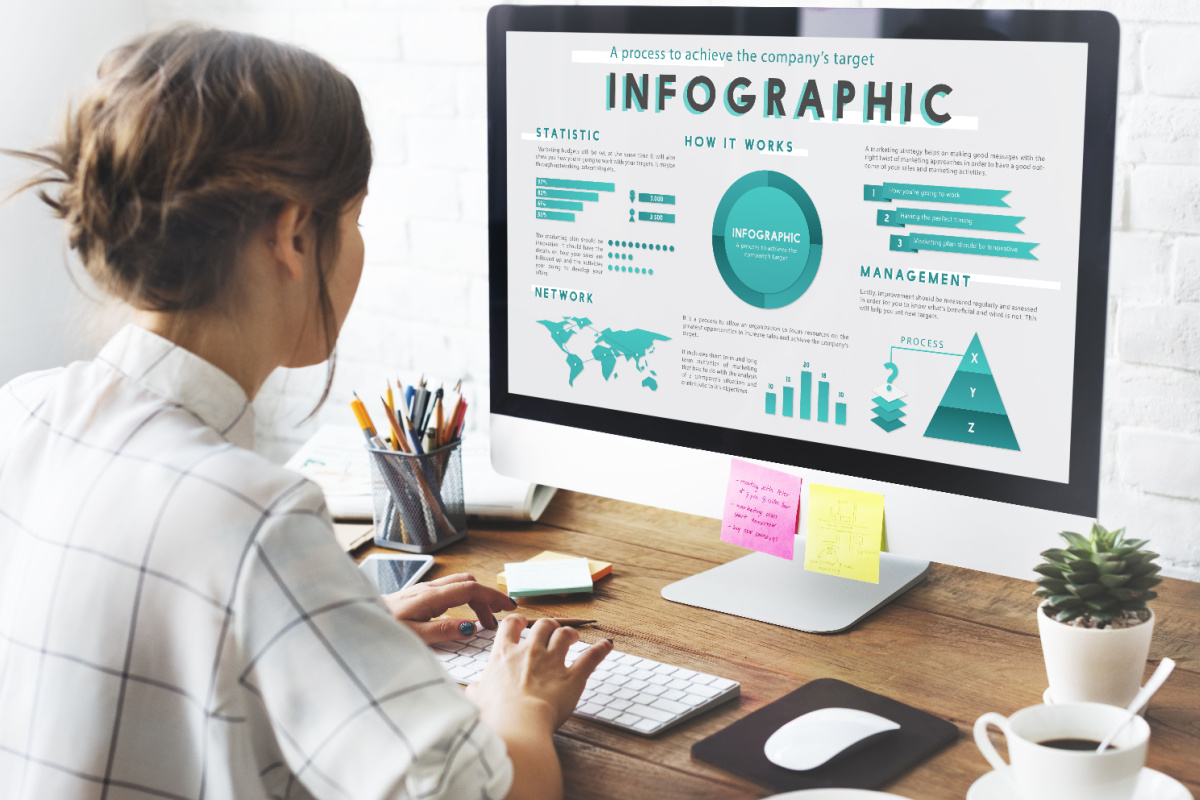
Infographics are powerful visual tools that simplify complex information, making them essential to modern legal content strategy. Effectively convey compelling messages, acting as a bridge between data and storytelling. Infographics have a rich history, with newspapers using them to sell papers and tell stories. An eye-catching headline accompanied by a pie chart, or even a simple bar graph, tells a story, a great recipe to move a stack of newspapers fast!
Today, law firms, including Cross Country Creatives’ clients like AKD Law and Corena Law, utilize infographics to illustrate statistics, such as car accident rates in specific cities and time periods. This visual approach not only engages audiences but also simplifies intricate legal concepts. As the digital marketing landscape evolves, infographics are a vital tool for law firms, offering a unique way to communicate complex legal matters effectively.
Forget dense text walls—to explain your goods and services, show, don’t just tell. Vivid infographics attract and educate audiences, spinning dry data into visual sticky stories.
Need to demo a new tool? Infographics map out key features and practical uses in colorful flowcharts and diagrams. Looking to train staff on complicated procedures? Simplify processes into infographic job aids easy to scan and remember.
Whether your goal is customer conversion or internal clarity, infographics speak volumes without saying much. Their blend of minimal text, data snapshots and eye-catching graphics informs audiences in an accessible way.
Give your product sheet a facelift with an infographic makeover. Watch those lengthy service descriptions transform into clean, visual explainers. See how infographics can untangle topics to spotlight what matters most.
With strategic design, infographics showcase offerings, demonstrate value and turn prospects into customers. Ditch the dense walls of text for visual media that clarifies, engages and persuades. A single striking infographic can amplify understanding better than pages of words alone.
Infographics allow law firms to communicate complex legal concepts and data in a visual format that is more engaging and understandable for audiences. Rather than relying solely on dense blocks of text, infographics use images, charts, graphs, and minimal text to convey the same information in a more consumable way.
Audiences better retain information from infographics compared to text alone. Additionally, infographics can help law firms stand out in a sea of content marketing. With visuals proving more popular on social media, infographics give law firms content that is primed for shares and engagement. Well-designed infographics also boost brand image for law firms, showing audiences they are modern, tech-savvy, and creative. Ultimately, leveraging infographics shows law firms are dedicated to educating audiences in the most compelling ways possible. In the legal industry, a picture really can be worth 1000 words.
When it comes to creating compelling infographics, the design itself is just as important as the data being conveyed. Law firms looking to add infographics into their content strategy should focus on several key design elements for maximum impact.
First, aim for simple, uncluttered designs. Legal concepts are intrinsically complex enough without the additional cognitive load of deciphering a busy, overworked infographic. Instead, streamline the information into clean visual chunks that are easy to digest. Use plenty of white space and an intuitive layout that draws the viewer’s eye logically from one element to the next.
Strategic use of color is another critical design consideration for legal infographics. Colors can highlight key statistics or data points, differentiate sections or topics, and add much needed visual appeal. But colors should enhance the infographic without distracting. Stick to a complementary color palette of 2-3 colors and use them intentionally to direct focus. Bolder pops of color like red or orange are great for callouts.
When it comes to imagery, legal infographics present some unique options like law books, scales of justice, gavels and more. Incorporating recognizable legal visuals makes the content more engaging and drives the legal theme home. Icons can also effectively represent concepts like trademarks, contracts, and other legal processes. Keep imagery consistent in style for a cohesive look.
For legal infographics, a length of 500-600 words total creates a good balance of thorough, informative content while remaining visually engaging. Too little information lacks substance but giant walls of text defeat the purpose of choosing an infographic in the first place.
Promotion is key to getting it in front of your target audience. Start by sharing it natively on your law firm’s website and embedding it in relevant blog posts and web pages. This makes the infographic easy to find and gives it a robust platform for organic search visibility.
Next, amplify it through social media platforms. Share it natively on LinkedIn and Twitter, accompanying it with concise text introducing the infographic and its value. Include visual-friendly hashtags and mention influencers or companies related to the infographic’s topic to expand reach.
Look for opportunities to repurpose the infographic content into other formats like blogs, case studies, and presentations. Extracting key data points or text can provide material for several derivative pieces of content from one infographic source.
Submitting infographics to legal publications and roundup posts is an effective link building tactic. Having an infographic feature brings referral traffic while boosting domain authority. Identify legal resources, blogs and aggregators accepting contributions and pitch them your best infographics.
Lastly, give your infographic added visibility through paid promotions on channels like LinkedIn and Twitter. Sponsored posts can further disperse your infographic to relevant audiences beyond your organic reach. With visually engaging infographics, a small ad spend goes a long way.

Start by tracking key engagement metrics on each infographic, including social shares, clicks, and any desired conversions like downloads or inquiries. This quantifiable data reveals how well your infographic is resonating and reaching audiences.
Monitor search engine rankings for the infographic as well as any keywords and topics targeted by the infographic. This allows you to gauge its organic visibility and SEO impact.
Solicit direct feedback on your infographics through surveys, polls or conversations with your audience. You can also A/B test different infographic styles and formats to see what performs best.
With the data, rankings, and feedback gathered, identify opportunities to refine your infographics to boost engagement and visibility. This may involve tweaking designs, integrating different interactive elements, or adjusting topic focus.
Think about the last time a striking statistic or data visualization stopped you on social media or while browsing. That hook, spark of interest, is precisely what legal content creators should harness with infographics. An eye-catching data point compels you to pause scrolling and learn more, legal infographics can capture attention and convey stories in a memorable way.
The advantage of infographics is they allow law firms to illustrate dry facts with visual impact and human connection. But to maximize their power, treat them not as one-off novelties, but as part of an evolving strategy. Continuously track performance, solicit feedback, and iterate on design. With experience, you’ll gain a keen sense for what makes legal infographics effective. The more you optimize, the better you get at transforming data into compelling visual content educates and converts.
So as you scroll through the sea of text-heavy content, think how your own posts can creatively capture interest. Legal content doesn’t have to be static words on a page. With infographics, you can reimagine how to tell legal stories in a language everyone understands – visually.
Get the latest posts in your email
Cross Country Creative offers legal advertising solutions, from a simple no obligation consultation to custom solutions. Let us know what we can do for you.
Contact UsThe internet has become an indispensable part of everyday life for people around the world. According to WHO, 15% of the world’s population has some kind of disability. There…
READ MOREInconsistent NAP (Name, Address, Phone) information can harm a legal business’s voice on search and affect credibility. We’ve all experienced driving to a new pizza pla…
READ MORECall-to-action phrases in advertising emerged in the early 20th century with the telephone and the development of media like radio and TV. Direct response ads urge readers or liste…
READ MORE